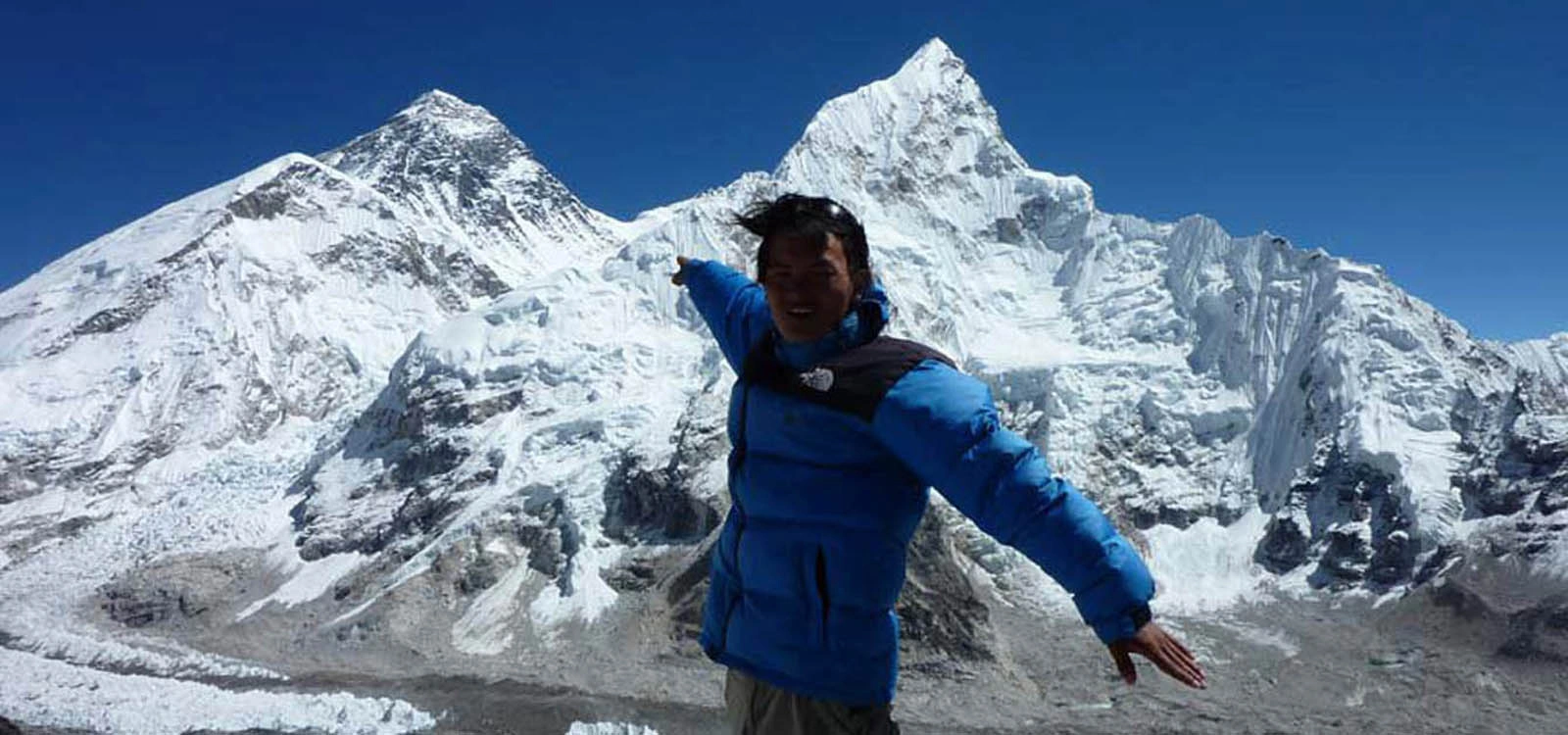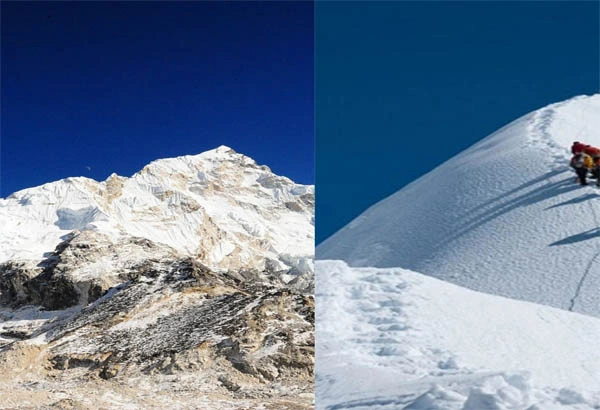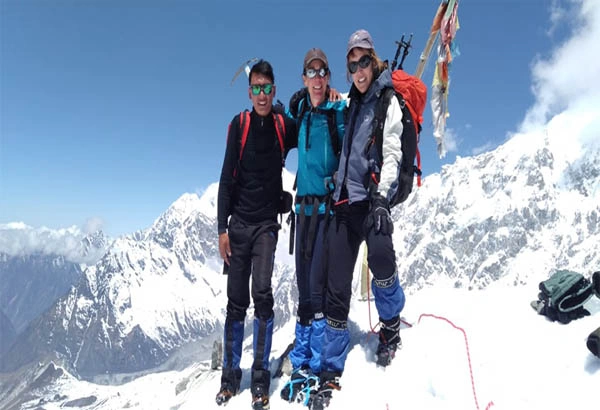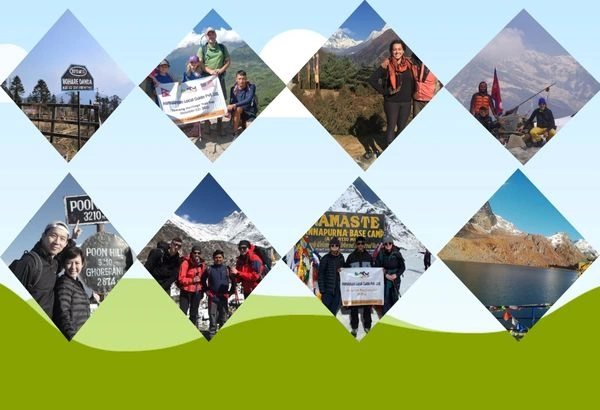Mount Everest (8,848 meters/29,028ft) is the world's highest mountain. Everest has attracted nature lovers, trekkers, and travelers since Edmund Hillary and Tenzing Norgay Sherpa climbed this mountain in 1953 A.D. However, some ideas state that George Mallory and Andrew Irvine might have climbed Everest in 1924 nearly three times more than Tenzing and Edmund.
Mt. Everest is the tallest mountain, and scientists consider that Everest is rising on average 4mm per year. As a part of the Himalayas range, Everest sits surrounded by whole mountains including Lhotse, Makalu, Cho Oyu, Khumbutse, and Nuptse. All Himalayas region altitudes rapidly, so trekkers need to acclimatize on their way to Everest Base Camp. The Nepalese Name for Everest is Sagarmatha, Tibetan Name is Chomolungma.
The Everest Base Camp (5364 meters/17,598ft) is the gateway point for those who want to expedite Everest. It is the highest point that most trekkers go to unless they want to climb Mount Everest. There are no teahouses and lodges at EBC. So you must stay a night at Gorkashep.
Sagarmatha area:
The Sagarmatha area lies in the northern-eastern part of Nepal in the Solokhumbu district. Sagarmatha itself lies inside Sagarmatha National Park is a UNESCO World Heritage site. The biggest town in the Everest region, which is called the Namche Bazaar is referred to as the entryway to the Mount Everest expedition as well Everest Base camp trek. Namche is also located in the Sagarmatha National Park.
The Khumbu region is home to various natural miracles. Due to the tall mountains surrounding Mount Everest, there are passes located in the locale of Everest. The main highlighted high passes are Renjo (5360 meters/17,585ft), Cho L Pass (5420 meters/17,782ft), and Kongma La Pass (5560 meters/18,241ft).
There are the glorious Gokyo Lakes at high elevations around from 4780 meters to 5000 meters, from the world's highest freshwater lakes. The prettiness of Gokyo lakes is elsewhere description.
Best time for EBC trek:
Trekkers explore the Everest Base camp during the year. However, trekking is easier at certain times than in others. Spring and autumn are the best time to discover the whole of Nepal trekking and tours. During this time skies are clear, mild temperatures and the vistas are delightful.
The summer season in Nepal accords with the monsoon, so the trekking trails are often rainy and slippery. The trekking regions below 3000 meters become heavy rain and the day might be cloudy. However, these difficulties excite a variety of treks who enjoy the ferocious rivers and fantastic waterfall vistas.
The winter season (December to February) gets heavy snowfall in the high elevations of the trekking trails. The cold may make the trek quite challenging, but expert trekkers can do the Everest Base camp trek during the winter periods.
Everest region trekking main highlights:
- Lukla is a tourist junction for Everest region trekking.
- Scenic flight to Lukla from Kathmandu or Ramechhap.
- High passes trek including; Renjo La, Cho La, and Kongma La Pass.
- Top of the world's highest mountain Mount Everest views.
- Magical Gokyo Lakes.
- High Elevation Mountains (Everest, Makalu, Cho Oyu, Lhoste.
- Delightful views from Gokyo Ri.
- Discover the Namche Bazaar.
- The world's highest airport at Syangbuche.
- Biggest monastery in Khumbu region (Tengbuche Monastery).
- UNESCO World Heritage Site ( Sagarmatha National Park)
- Flora and fauns during the trekking.
- Sunrise views from the Kalapathar (5545 meters).
- Wildlife animals such as musk deer, snow leopards, and Himalayan Thars.
- Khumbu Glaciers.
Trekking Difficulty: Challenging
The Everest Base camp trekking is quite a moderate to challenging trip in the Everest region. But you need a good physical fitness level to complete the Everest Base camp trek. However, if you have experience in these fields, you can complete this trek.
The main highest point for EBC treks is Kala Patthar (5545meters) above sea level, from where you can get magical vistas of the mountains range with sunrise.
Trekking in the high altitudes is exhaustive, and you must prepare to walk for six to seven hours. There are ascending, descending, and straightforward trekking trails difficult.
However, if you have facture and cannot walk to the Everest Base camp trek, you have another alternative to view Mount Everest. You can ridge a helicopter tour to EBC is also easy and comfortable.
What are the possible treks in the Everest region?
Everest region trekking provides various trekking possibilities. There are different trekking routes. The Everest Base camp trek from Phaplu, Shivalaya Jiri, or a short flight to Lukla and progresses throughout Phakding, Namche Bazaar, Tengbuche, Dingbuche, Labuche, Gorkashep and finally, visit Everest Base camp.
During the EBC treks, several are based on the trekking trails route and the venues you visit. It also depends on your time frames and the mode of transportation you take.
Here are some of the Everest regions trekking Route, you may choose yourself:
- Everest Base Camp trek
- Everest Base Camp trek via Gokyo Lake
- Everest Three Passes trek
- Everest view trek
- Phaplu to Everest Base Camp trek
- Jiri to Everest Base Camp trek
How to prepare for the EBC trek:
Everest Base camp trekking is typically thought a generally needed healthy trekker can complete this trek; the fitter you are the more you will take pleasure in your trek. So, we suggest you participate in strength-building exercises a few months before coming to Nepal trek. You can do some cardio exercise, swim, morning walk, and cycling. It is also a good suggestion to take part in short hiking; that lasts for six to seven hours.
EBC trek is located; at a high elevation. However, you must take warm clothes, like a down jacket, Sleeping bag, water and windproof jacket, thick shock, and trekking boats. Do not forget to take a high-quality camera or Phone as you will witness the most severe and exhilarating high-elevation terrain, which you may want to capture with your camera.
Travel insurance:
Everest base camp trek takes you low to high-elevation hikes that come with risks of high-altitude sickness. So, adequate insurance is one of the most important for human life during travelling. Before buying your travel insurance policy, ensure that your travel insurance covers helicopter rescue at altitudes up to 6000 meters. It is most necessary because Everest trekking is still untouched by road.
We suggest you call your insurance provider and confirm that they cover Helicopter rescue at high elevations up to 6000 meters and medical care. Please do not just rely on what the travel insurance companies say on their web pages.




